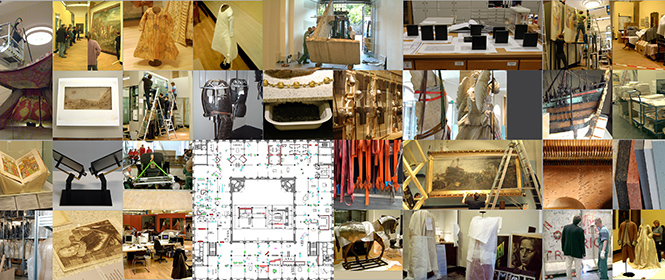
Moving XXL: The tasks of the conservators
Michaela Brand | 13 July 2021
After being presented in this form for 15 years, the Permanent Exhibition (PE) “German History. From the Middle Ages to the Fall of the Berlin Wall” will be closed for renovations and the objects will be removed in the time between July and December 2021. It will be a huge, exciting, logistical project for all involved. In our interview, Michaela Brand, book conservator at the Deutsches Historisches Museum, talks about the work of conservators in this context.
Frau Brand, you have had to do with the Permanent Exhibition in the Zeughaus since it was opened in 2006. can you give us an idea about how many objects in how much space could have been seen here?
With pleasure. In the Zeughaus we have a surface area of 7500 m² on two floors. Around 6000 objects were displayed here, arranged in different epochs. The exhibition architecture comprises no less than 585 showcases and 409 mounting walls.
And how great a variety of objects did it contain? What is the largest object and what the smallest? What was the oldest and the youngest object in this historical exhibition?
There is no end to the variety of objects in the Permanent Exhibition: medieval paintings and sculptures, textiles, military armaments over the centuries, everyday objects, and much more. The smallest piece was a penny, 1.1 cm in diameter, weighing 0.24 grams. The largest object was an anti-aircraft gun – when ready to fire, it is 2.41 m high, 2.30 m wide, and 7.62 m long. It weighs 5 tons. The oldest objects were two conical helmets from the 6th century. The youngest was a 1€ coin from the year 2002.
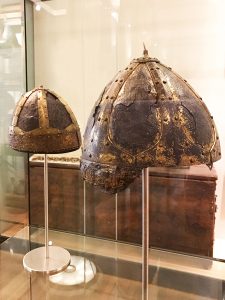
Two conical helmets from the 6th century are the oldest objects in the PE. © DHM
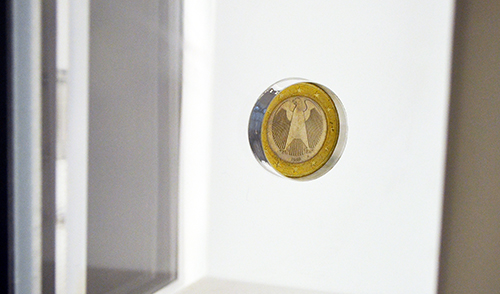
The youngest object was this 1€ coin from the year 2002. © DHM
How are we to imagine the work of clearing out so large an exhibition with so many different objects?
The heads of the conservation department first began the planning three years ago and drafted a temporary time schedule and a logistical plan for removing the objects, a very complex undertaking. The sequence of the removal of the objects begins with emptying the walls: the graphics, posters and paintings will be taken down first. In the second stage, the showcases will be cleared out. The exhibition architecture – walls, showcases, etc. – can only begin to be removed after all the objects have been taken out. An exception to this procedure are the large objects, such as automobiles and sections of the Berlin Wall, which require more space and can only be removed after the architectural elements have been cleared out.
Who else is involved in dismantling the exhibition?
As the central interface, the registrars coordinate the workflow between all those who are involved and supervise the different steps in the removal and transport of the objects. In smaller houses with fewer personnel, the curators or members of the collection departments sometimes remove the objects themselves, while in others, an external company specialised in handling art objects would be hired. At the DHM the dismounting and removal of the objects is carried out by the conservators with the help of technicians. At this time, every object that is removed is registered in writing and photographed, its current condition is described, and changes that might have occurred are noted in a condition report or protocol.
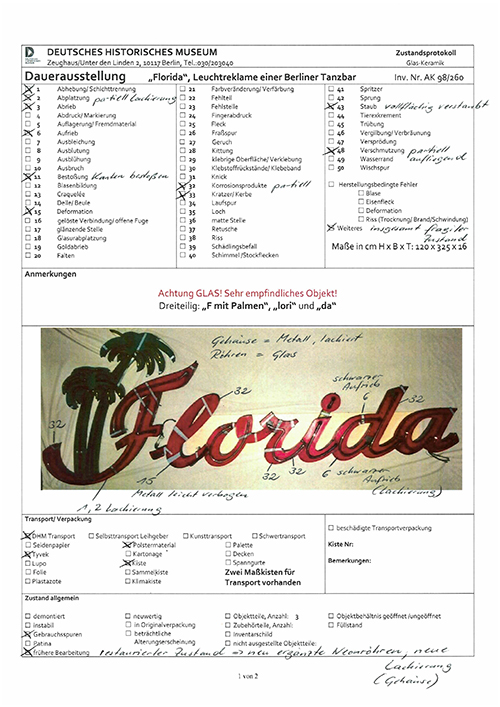
Example of a condition report1, here made by the glass and ceramics conservation department. © DHM
That must be very time-consuming. How many people work in conservation?
There are 17 permanently employed conservator, who are specialised in nine material groups: metal, textiles, wood, paintings, glass/ceramics, paper, posters, books and plastics. For several of the long-time employees, this is the third time they have participated in dismantling a permanent exhibition in the course of their eventful careers, from the Museum für Deutsche Geschichte in the GDR to the present time.
Can you tell us about the different activities of a conservator?
The public perception of our profession is often veiled in an exaggeratedly romantic aura. It reduces us down to the lone conservator pensively standing before an easel and dabbing a few dots of paint onto an ancient painting, or solemnly bringing a fragile object into an exhibition with white-gloved hands.
The prosaic practice of our job after our studies, which today are to be completed with a bachelor or master’s degree – often after the respective craft apprenticeship and an internship lasting from one to several years at museums or other training organisations –, is now far more diversified and with greater emphasis on science and technology. Due to our technical knowledge and expertise in the make-up of the objects, we often take part in important advisory and communicative functions in the interdisciplinary cooperation within the overall structure of the museum. Alongside practical conservation measures, our conservational activities are very important for the collections. Our field of activities ranges from special expertise for new acquisitions to extensive planning of new depots and the general climate control in a great variety of situations. In addition, there are the preventive tasks such as integrated pest management, whereby the various pests that can infest the cultural collections have to be monitored.
An example of a complex practical task of the textile conservation department in the museum is the presentation of clothing and its storage in depots. The conservators develop substructures and make them individually, because for the optimal presentation or storage of pieces of clothing it is important to know whether the original wearer was thin or corpulent and what kind of a figure they had. Thanks to the thriving exhibition activities of the DHM, we conservators gather a great variety of experience and develop essential presentation solutions. The display mounts must not cause any damage to the objects, must be durable and stable, and at the same time elegant and optically unobtrusive.
[Here you can see Paper Conservator Matthes Nützmann at work: https://www.youtube.com/watch?v=sfHdjCsCWaA]
Do you have other examples of this?
Yes, for the Permanent Exhibition we conceived our own special innovative presentation aids. For instance, we developed a new kind of museumboard construction for around 700 paper objects, which allows visitors to see the unframed, i.e., unglazed objects in the showcases without reflections. Extensive material research and mounting attempts led to this solution, which now, 15 years later, have proven over time to be highly successful.
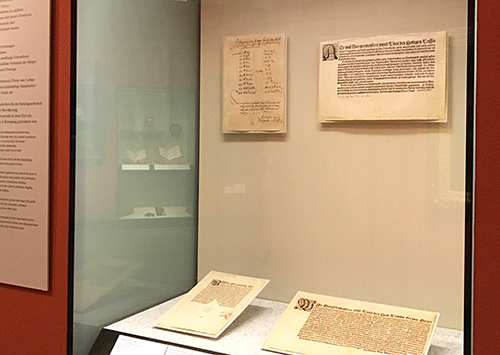
Vertical mounting system without glazing. The shadow gap that thus occurs on the back wall of the showcase underscores the individual character of every hanging object. © DHM
Let’s get back to the dismounting of the Permanent Exhibition. What will your work look like now?
All of the tasks of setting up, mounting and installing that we just described will be carried out in reverse order.
The objects will be packed according to their kind, e.g., in tissue paper and glassine bags. Or laid textiles in corrugated cardboard boxes, or paintings in air conditioned cases. In the case of freestanding objects, the surface is to be cleaned before removal, if possible. The transport of large objects, as I mentioned, is carried out by special art logistics companies. The registrars are in charge of everything that then follows. They organise and supervise their own transports and those of the external shipping companies to the collection depots and also guarantee in addition to the depot employees for the continuous updating of the locations of the objects in the database. As soon as all the objects are in the temporary depots, the technicians can begin dismantling the exhibition architecture. The Zeughaus has to be completely emptied before the renovation begins.
Frau Brand, thank you very much for this conversation and the fascinating insight into your work. We wish you all success in the coming months.
1) The registered object here, the neon sign “Florida”, is from a dance bar in Berlin-Wedding and dates from 1956/1960. The capital letter “F” in the logo is decorated with two palm trees. The neon logo is made of sheet iron and the letters are three-dimensional. Glass tubes filled with illuminating gas are attached to the individual letters.
|
Total number of visitors: almost 7 million |